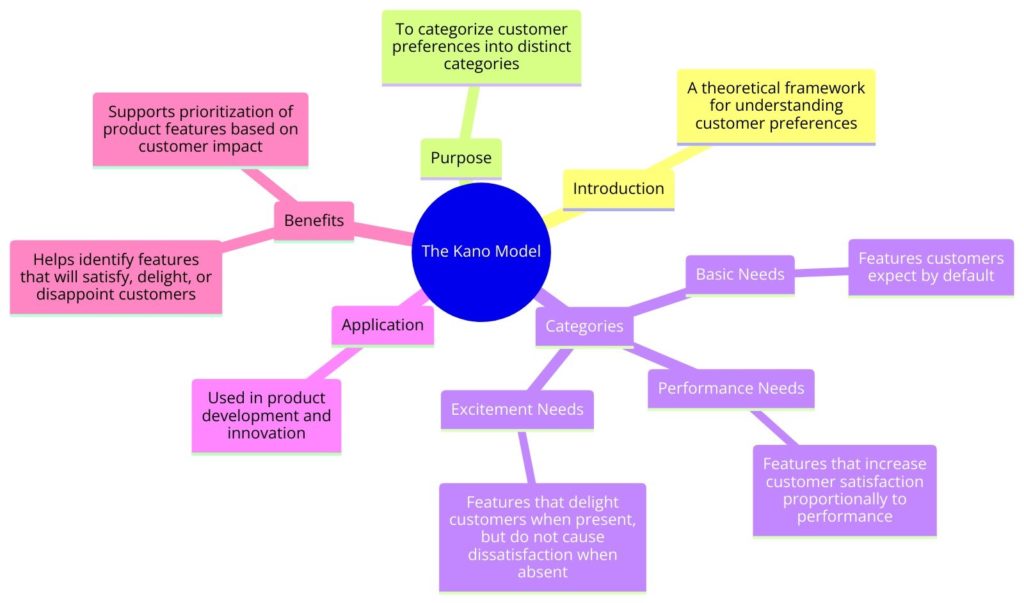Kano Model
The Kano Model is a theoretical framework used to categorize customer preferences into distinct categories. Developed in the 1980s by Professor Noriaki Kano, it presents a unique perspective on product features and their impact on customer satisfaction. Unlike traditional models that assume a linear relationship between feature performance and customer satisfaction, the Kano Model illustrates that the relationship is more complex and can be categorized into five distinct types of customer preferences: Must-Be, One-Dimensional, Attractive, Indifferent, and Reverse.
What is the Kano Model?
The Kano Model helps organizations understand how different types of product features contribute to customer satisfaction and loyalty. By identifying which features are essential to customers and which can truly delight them, companies can prioritize development efforts more effectively. The model’s five categories of customer preferences are:
- Must-Be Quality: These are the basic features that customers expect. Their absence causes dissatisfaction, but their presence does not significantly increase satisfaction.
- One-Dimensional Quality: These features result in satisfaction when fulfilled and dissatisfaction when not fulfilled. Customer satisfaction is proportional to the level of performance of these features.
- Attractive Quality: These are features that customers don’t explicitly expect, but when present, they can significantly increase satisfaction. Their absence does not cause dissatisfaction because customers didn’t expect them in the first place.
- Indifferent Quality: These features do not significantly affect customer satisfaction, whether they are present or not, as customers are indifferent to them.
- Reverse Quality: Features that can cause dissatisfaction when present and satisfaction when absent. Different customer segments may have different perceptions of these features.
Origin of the Framework
The Kano Model was developed by Noriaki Kano in the 1980s. It was born out of the realization that not all product features have the same impact on customer satisfaction. Kano, a professor at Tokyo Rika University (now Tokyo University of Science), initially introduced the model in the Japanese Journal of Quality Control. The framework has since gained international recognition and is applied across various industries to enhance product development and customer experience.
How It Works
To use the Kano Model, organizations typically conduct surveys asking customers to rate how they would feel if a product had a certain feature (Functional Form) and how they would feel if it did not have that feature (Dysfunctional Form). The responses are then analyzed to categorize features according to the Kano Model categories.
The Kano analysis process involves several steps:
- Designing the questionnaire: Prepare questions that explore customer reactions to the presence or absence of potential product features.
- Collecting data: Survey customers to capture their preferences and expectations.
- Analyzing results: Use the Kano evaluation table to categorize features into Must-Be, One-Dimensional, Attractive, Indifferent, and Reverse qualities.
- Prioritizing features: Decide which features to include in the product roadmap based on their potential impact on customer satisfaction.
Why It Is Valuable
The Kano Model provides several key benefits:
- Enhanced Customer Satisfaction: Helps identify features that will significantly impact customer satisfaction.
- Resource Allocation: Guides organizations on where to allocate development resources for the greatest impact on satisfaction and differentiation.
- Product Differentiation: Identifies opportunities to include attractive qualities that can distinguish a product in the marketplace.
- Strategic Planning: Aids in strategic planning by revealing customer preferences and expectations over time, as customer perceptions can shift from Attractive to Must-Be qualities.
When and How to Use It
The Kano Model can be applied during the product development process, particularly in the early stages when defining requirements and prioritizing features. It is also useful for ongoing product enhancement and when entering new markets.
Shortcomings/Criticisms
While widely praised, the Kano Model has some limitations:
- Subjectivity: The categorization of features can be subjective and may vary across different customer segments.
- Dynamic Nature: Customer perceptions can shift over time, with Attractive features becoming Must-Be features as market expectations change.
- Survey Dependence: The model relies heavily on survey data, which can be influenced by how questions are phrased and the respondents’ current mood or understanding.
The Kano Model offers a nuanced approach to understanding customer satisfaction, providing valuable insights for product development and enhancement. Despite its shortcomings, it remains a powerful tool for prioritizing features and delivering products that not only meet basic customer expectations but also offer delightful experiences that can differentiate a product in the market.


